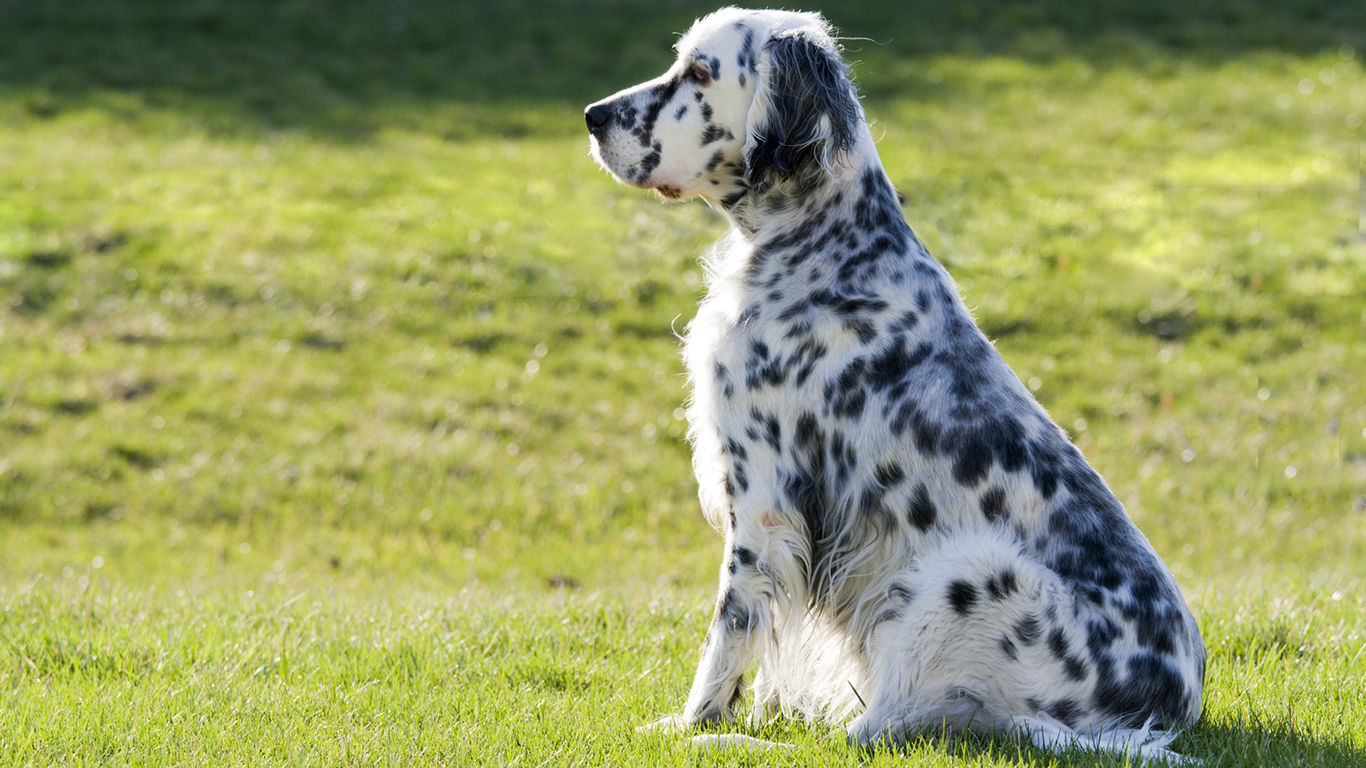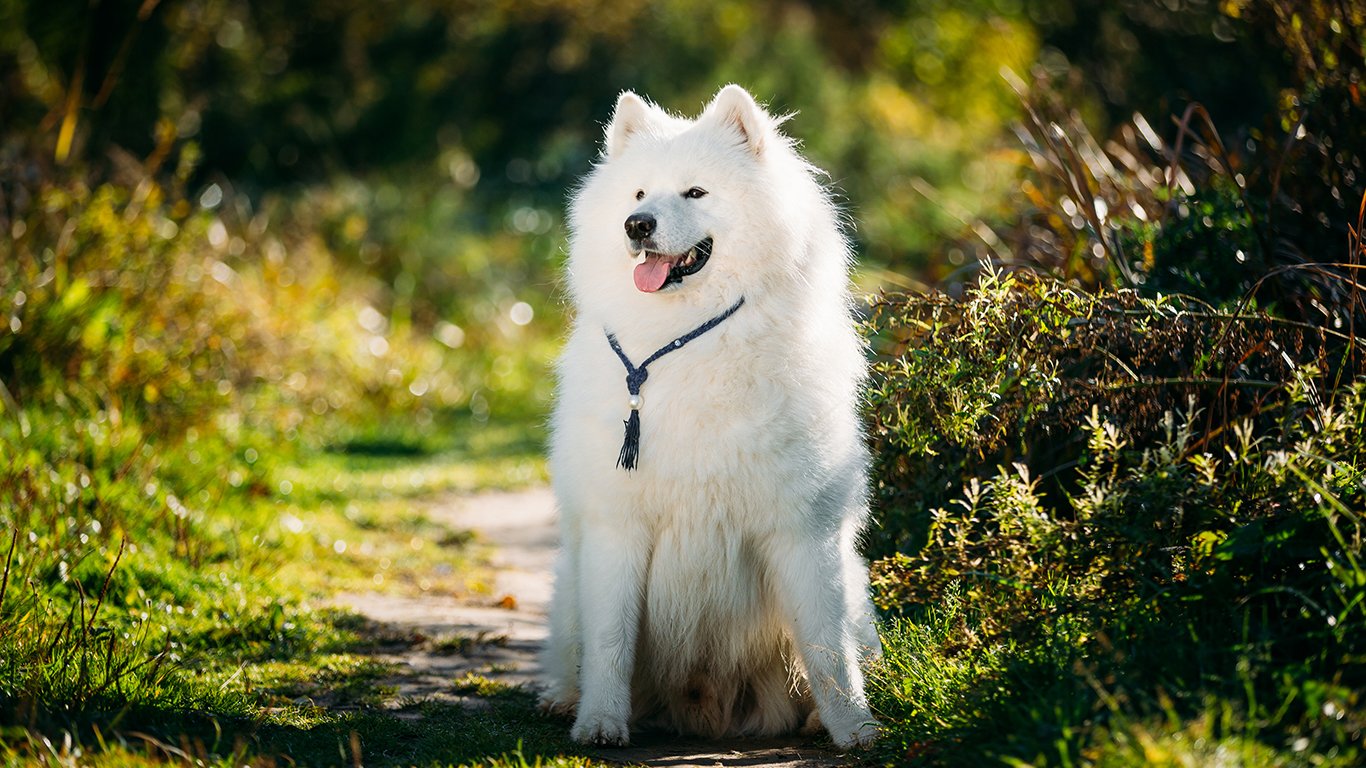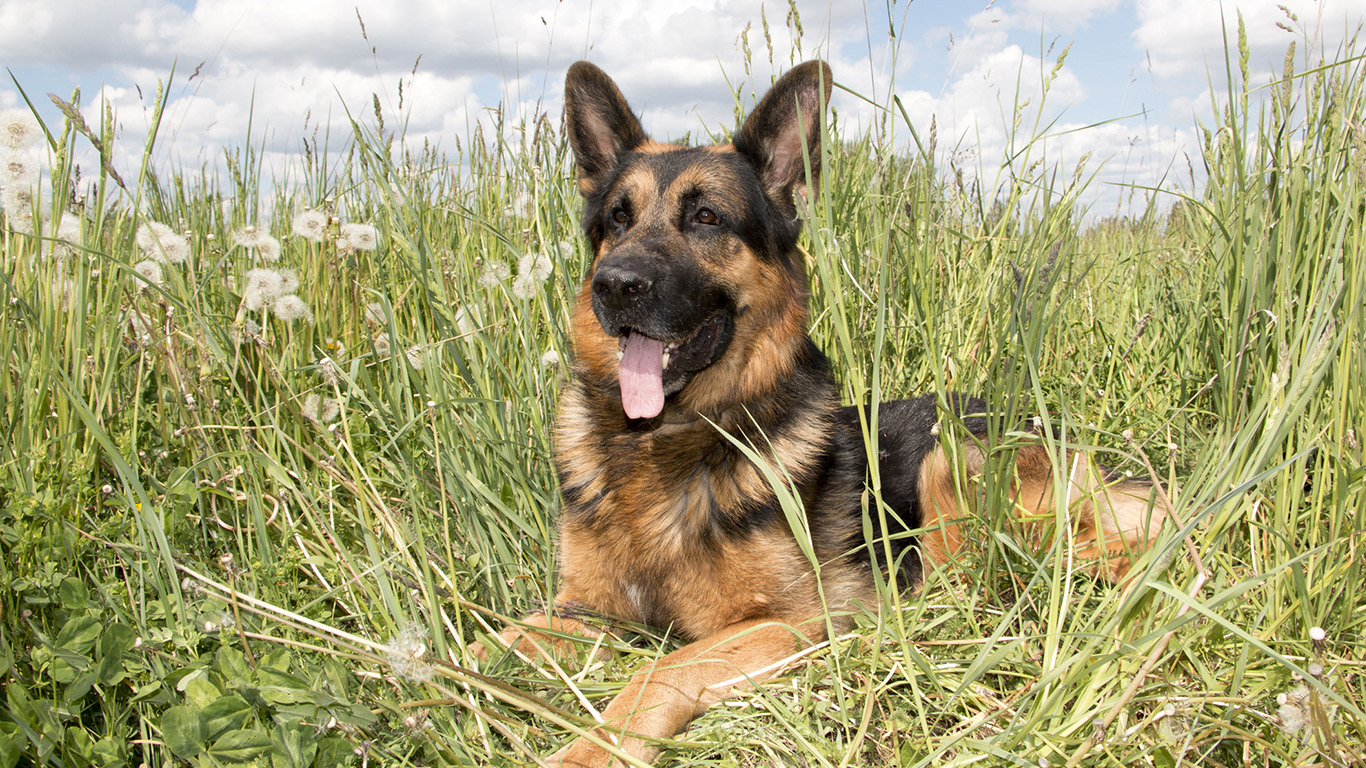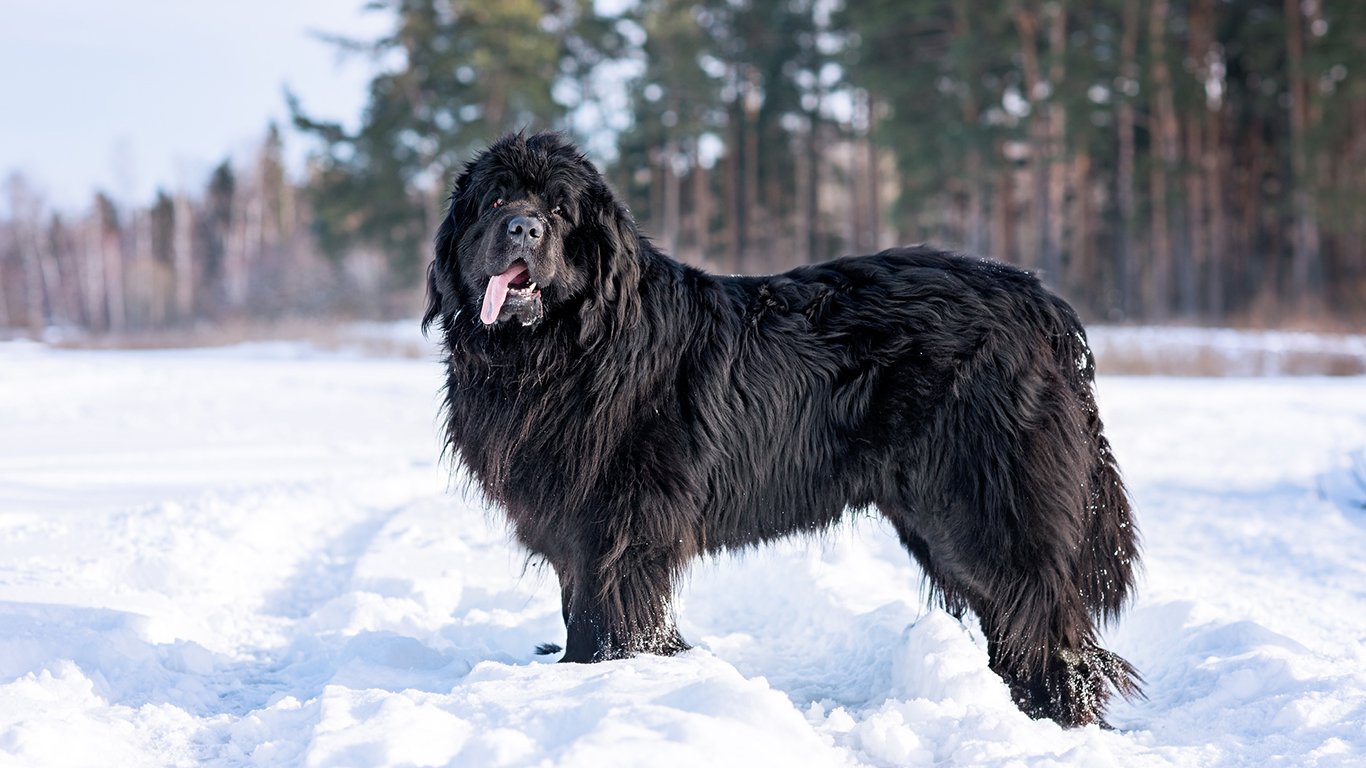Special Report
Shortest (and Longest) Living Dog Breeds in the World
Published:
Last Updated:

To determine the dog breeds that have the longest and shortest life expectancy, 24/7 Wall St. reviewed the average age of death for 148 dog breeds from research published by the National Center for Biotechnology Information. In addition to weight and height information, we reviewed various character traits of the breeds, including trainability.
Click here to see the shortest living dogs.
Click to here to see the longest living dogs.
Click here to read our detailed findings and methodology.
Shortest Living Dog Breeds

40. Airedale Terrier
> Life expectancy: 11.2 years
> Height: 23 inches
> Weight: 55 pounds
> Easy to train?: Yes
The largest of all terriers, the Airedale terrier is an intelligent breed that thrives on physical and mental challenges.
[in-text-ad]

39. English Setter
> Life expectancy: 11.2 years
> Height: 26 inches
> Weight: 68 pounds
> Easy to train?: Yes
The English setter is recognized by its elegant coat, but is also well known with hunters as a gundog.

38. Akita
> Life expectancy: 11.0 years
> Height: 27 inches
> Weight: 108 pounds
> Easy to train?: Yes
The Akita is a large, powerful breed originating in Japan known for its use in therapy and its trademark curling tail.

37. American Water Spaniel
> Life expectancy: 11.0 years
> Height: 17 inches
> Weight: 38 pounds
> Easy to train?: Yes
The American water spaniel is a very rare and active breed developed for hunting. It is the official State Dog of Wisconsin.
[in-text-ad-2]

36. Basenji
> Life expectancy: 11.0 years
> Height: 17 inches
> Weight: 24 pounds
> Easy to train?: No
It’s rare to find a small dog with a relatively short life expectancy, but the basenji comes in at a light 24 pounds. And yes, this short-haired African hunting dog really doesn’t bark.

35. Belgian Malinois
> Life expectancy: 11.0 years
> Height: 25 inches
> Weight: 68 pounds
> Easy to train?: Yes
The Belgian Malinois, a big, high-energy dog, got its name after being bred in the Belgian city of Malines.

34. Borzoi
> Life expectancy: 11.0 years
> Height: 28 inches
> Weight: 90 pounds
> Easy to train?: No
Bred to be swift and strong hunters, the borzoi can reach speeds of 35 to 40 miles per hour. Compared to the nearly 150 breeds reviewed, the Borzoi is the eighth tallest.

33. Bouvier Des Flandres
> Life expectancy: 11.0 years
> Height: 26 inches
> Weight: 95 pounds
> Easy to train?: Yes
Originally used as a cattle herd and farm helper, the Bouvier Des Flandres is an imposing breed with a big heart.

32. Briard
> Life expectancy: 11.0 years
> Height: 25 inches
> Weight: 85 pounds
> Easy to train?: No
The briard are large, wavy-haired dogs known for being agile on their feet.

31. Chesapeake Bay Retriever
> Life expectancy: 11.0 years
> Height: 25 inches
> Weight: 73 pounds
> Easy to train?: Yes
This family-oriented dog has a waterproof coat that’s oily to the touch. The Chesapeake Bay Retriever is the official Maryland State Dog.

30. English Bulldog
> Life expectancy: 11.0 years
> Height: 24 inches
> Weight: 50 pounds
> Easy to train?: No
Quiet and peaceful, it takes a tremendous amount of teasing to provoke the sweet-natured English bulldog.
[in-text-ad]

29. Giant Schnauzer
> Life expectancy: 11.0 years
> Height: 26 inches
> Weight: 70 pounds
> Easy to train?: Yes
The active and imposing giant schnauzer is also hypoallergenic. So while this breed may not tend to live as long as many others, it is a great companion for pet lovers who are allergic to dogs.

28. Ibizan Hound
> Life expectancy: 11.0 years
> Height: 25 inches
> Weight: 50 pounds
> Easy to train?: No
The Ibizan hound is a historic dog. It is mostly recognized for its familiar ears and elongated head that resembles Anubis, ancient Egypt’s protector of the dead.

27. Irish Water Spaniel
> Life expectancy: 11.0 years
> Height: 23 inches
> Weight: 60 pounds
> Easy to train?: Yes
The Irish water spaniel is hypoallergenic and an avid swimmer. While not the tallest breed, it is also the tallest of all spaniels.

26. Samoyed
> Life expectancy: 11.0 years
> Height: 22 inches
> Weight: 55 pounds
> Easy to train?: No
This smiling dog was bred for hard work in cold terrains with its heavy and weather-resistant coat.

25. Welsh Terrier
> Life expectancy: 11 years
> Height: 15 inches
> Weight: 20 pounds
> Easy to train?: No
The Welsh terrier is a friendly dog recognizable by its long beard.

24. Cavalier King Charles Spaniel
> Life expectancy: 10.7 years
> Height: 13 inches
> Weight: 16 pounds
> Easy to train?: Yes
This pint-sized pup was perhaps first known as the preferred pet of King Charles II. The Cavalier King Charles Spaniel remains quite popular.

23. Boxer
> Life expectancy: 10.4 years
> Height: 24 inches
> Weight: 70 pounds
> Easy to train?: Yes
The boxer is a tall, muscular dog whose original use was as a police dog.

22. German Shepherd
> Life expectancy: 10.3 years
> Height: 25 inches
> Weight: 83 pounds
> Easy to train?: Yes
A true dog-lover’s dog, the German shepherd is an all-purpose worker and the AKC’s second most popular breed of all time.
[in-text-ad-2]

21. Greater Swiss Mountain Dog
> Life expectancy: 10.2 years
> Height: 27 inches
> Weight: 135 pounds
> Easy to train?: Yes
These immense dogs weigh as much as a mid-sized human, but they are famously even-tempered and family oriented. The breed is sixth heaviest of all breeds considered for this ranking.

20. Dogue de Bordeaux
> Life expectancy: 10 years
> Height: 27 inches
> Weight: 133 pounds
> Easy to train?: No
The dogue de Bordeaux is a large, laidback breed rooted in ancient France. Like most other relatively short-living dog breeds, the average weight of dogs in this breed, at 133 pounds, is well above average.
[in-text-ad]

19. French Bulldog
> Life expectancy: 10 years
> Height: 17.75 inches
> Weight: 36.75 pounds
> Easy to train?: No
Great for singles and small families, the French bulldog is a relaxed and loyal dog. Unlike almost every other dog on this list, the French Bulldog is not very large.

18. Newfoundland
> Life expectancy: 10 years
> Height: 28 inches
> Weight: 140 pounds
> Easy to train?: Yes
A master at long-distance swimming, the Newfoundland is a massive work dog with lifesaving instincts. Compared with other breeds, the Newfoundland is the fourth heaviest, and eighth tallest.

17. Norfolk Terrier
> Life expectancy: 10 years
> Height: 10 inches
> Weight: 12 pounds
> Easy to train?: No
This fearless and active dog is admired by farmers and hunters alike for his eagerness, loyalty, and charm.

16. Staffordshire Bull Terrier
> Life expectancy: 10 years
> Height: 17 inches
> Weight: 48 pounds
> Easy to train?: Yes
The Staffordshire bull terrier is heavy for a dog its size — that’s because it is muscular and rock-solid. Staffordshires are pit bulls, which is a slang term for dogs bred for fighting.

15. Weimaraner
> Life expectancy: 10 years
> Height: 26 inches
> Weight: 63 pounds
> Easy to train?: No
Often called the “gray ghost” for its short, sleek coat, the Weimaraner is the ideal companion for runners because of its exceptional speed and endurance.
[in-text-ad-2]

14. Doberman Pinscher
> Life expectancy: 9.8 years
> Height: 27 inches
> Weight: 75 pounds
> Easy to train?: Yes
The Doberman are a highly energetic and fearless breed from Germany where they were originally used as police dogs.

13. Rottweiler
> Life expectancy: 9.8 years
> Height: 25 inches
> Weight: 113 pounds
> Easy to train?: Yes
Rottweilers are reserved with strangers but affectionate with family members, and they love to be busy. The AKC recommends rottweilers get two solid workouts a day.

12. Flat Coated Retriever
> Life expectancy: 9.5 years
> Height: 24 inches
> Weight: 68 pounds
> Easy to train?: Yes
Named for its highly-functional coat, the flat-coated retriever is protected from harsh weather, icy water, and is known for its endurance in punishing terrain.

11. Scottish Deerhound
> Life expectancy: 9.5 years
> Height: 31 inches
> Weight: 88 pounds
> Easy to train?: No
At one point in time, only nobles and dignitaries owned this ancient and elegant breed. The Scottish deerhound is one of the largest breeds, even among relatively short-living dogs. A typical Scottish deerhound, at 31 inches, is the third tallest breed.

10. Rhodesian Ridgeback
> Life expectancy: 9.1 years
> Height: 26 inches
> Weight: 85 pounds
> Easy to train?: Yes
The Rhodesian ridgeback is a large and muscular dog that was originally bred to hunt lions.
[in-text-ad]

9. Chinese Shar-Pei
> Life expectancy: 9 years
> Height: 19 inches
> Weight: 53 pounds
> Easy to train?: No
One of only two dog breeds with a blue-black tongue, the Chinese shar-pei is recognized by the abundant folds on its face, neck, and shoulders.

8. Saint Bernard
> Life expectancy: 9 years
> Height: 28 inches
> Weight: 150 pounds
> Easy to train?: Yes
The Saint Bernard is a world-famous gentle giant that could act as a “nanny dog” for children. At an average of 150 pounds, the Saint Bernard is the second-heaviest out of 148 breeds.

7. Bullmastiff
> Life expectancy: 8.6 years
> Height: 28 inches
> Weight: 144 pounds
> Easy to train?: No
The bullmastiff is a large, strong dog with roots that can be traced to England around 1860.

6. Bloodhound
> Life expectancy: 8.5 years
> Height: 26 inches
> Weight: 90 pounds
> Easy to train?: No
A famous wrinkled face, the bloodhound can follow a trail on a rough terrain for hours but according to owner reports these pets can be lethargic around the house.

5. Great Dane
> Life expectancy: 8.4 years
> Height: 32 inches
> Weight: 140 pounds
> Easy to train?: Yes
Great Danes are easily recognizable — on their hind legs they are often taller than most humans. At an average of 32 inches to the shoulder, the Great Dane is the tallest dog.

4. Mastiff
> Life expectancy: 7.5 years
> Height: 30 inches
> Weight: 160 pounds
> Easy to train?: Yes
Due to their large size, mastiffs make an immediately imposing impression on newcomers, but they are known for being good-natured and docile. The mastiff is the heaviest dog, clocking in at an average of 160 pounds.

3. Bernese Mountain Dog
> Life expectancy: 7 years
> Height: 26 inches
> Weight: 85 pounds
> Easy to train?: Yes
Originally used to perform work on Swiss farms, this large, intelligent breed loves any sort of outdoor activity.

2. Bulldog
> Life expectancy: 6.7 years
> Height: 24 inches
> Weight: 50 pounds
> Easy to train?: No
Known to be happy, heavy, and lazy, bulldogs will never beg to be walked but will still love to be your lapdog.
[in-text-ad-2]

1. Irish Wolfhound
> Life expectancy: 6.2 years
> Height: 32 inches
> Weight: 120 pounds
> Easy to train?: No
Tied with the Great Dane as the tallest of all dog breeds, the Irish wolfhound is a massive, muscular dog. Perhaps at odds with its imposing appearance, owners of this breed report Irish wolfhounds as calm and quiet dogs.
Longest Living Dog Breeds

40. Greyhound
> Life expectancy: 13.2 years
> Height: 29 inches
> Weight: 68 pounds
> Easy to train?: No
According to the AKC, greyhounds are the fastest dogs in the world. They have long been the object of fascination of artists, poets, and kings.
[in-text-ad]

39. Cairn Terrier
> Life expectancy: 13.2 years
> Height: 10 inches
> Weight: 14 pounds
> Easy to train?: No
Originally bred to aid Scottish farmers in catching pests, you probably know the most famous cairn terrier in the world as Toto from the “Wizard of Oz.”

38. Beagle
> Life expectancy: 13.3 years
> Height: 14 inches
> Weight: 26 pounds
> Easy to train?: Yes
This loyal and ancient breed was bred to hunt rabbits. It loves the company of other dogs.

37. Pekingese
> Life expectancy: 13.3 years
> Height: 8 inches
> Weight: 9 pounds
> Easy to train?: Yes
The Pekingese, named after the city of Peking now called Beijing, were abundant in ancient Chinese art. Like many long-living dog breeds, the Pekingese, which has an average height and weight of 8 inches and 9 pounds, is one of the smallest breeds available.

36. Shetland Sheepdog
> Life expectancy: 13.3 years
> Height: 14 inches
> Weight: 25 pounds
> Easy to train?: Yes
This easy to train dog is extremely intelligent and is a world-class contender in obedience, agility, and herding competitions.

35. Shih Tzu
> Life expectancy: 13.4 years
> Height: 10 inches
> Weight: 13 pounds
> Easy to train?: No
This toy dog looks like a mini lion. Mentions of the breed in documents and paintings date back to AD 624.
[in-text-ad-2]

34. American Eskimo Dog
> Life expectancy: 13.5 years
> Height: 14 inches
> Weight: 15 pounds
> Easy to train?: No
The “Eskie” was once used as a circus dog and is known for its white coat and triangular ears. With its famous white double coat, this breed is particularly well-suited for colder climates.

33. Australian Cattle Dog
> Life expectancy: 13.5 years
> Height: 19 inches
> Weight: 45 pounds
> Easy to train?: Yes
The agility, strength, and courage of the Australian cattle dog make this breed a willing and efficient cattle herder that can work all day.

32. Brussels Griffon
> Life expectancy: 13.5 years
> Height: 8 inches
> Weight: 9 pounds
> Easy to train?: Yes
This toy dog is an affectionate breed that with a ready and noisy bark makes a good watchdog despite its small stature. Brussels Griffons tend to be just 8 inches tall and weigh on average just 9 pounds.

31. Chow Chow
> Life expectancy: 13.5 years
> Height: 18.5 inches
> Weight: 60 pounds
> Easy to train?: No
The Chow Chow is a powerfully built dog with a distinctive lion’s-mane and a blue-black tongue. Chow Chows, weighing on average about 60 pounds, are larger than most long-living dog breeds.

30. Glen of Imaal Terrier
> Life expectancy: 13.5 years
> Height: 14 inches
> Weight: 35 pounds
> Easy to train?: No
Glen of Imaal terriers were initially bred to rid the house of vermins. These small shaggy dogs were originally bred in Ireland for hunting.
[in-text-ad]

29. Shiba Inu
> Life expectancy: 13.5 years
> Height: 15 inches
> Weight: 25 pounds
> Easy to train?: Yes
The shiba inu is the most popular breed in its homeland of Japan. The breed was introduced to the United States as recently as 60 years ago.

28. Lakeland Terrier
> Life expectancy: 13.5 years
> Height: 14 inches
> Weight: 17 pounds
> Easy to train?: No
Initially bred to protect sheep from foxes, the lakeland terrier is a small working dog recognized by its distinctive beard.

27. Maltese
> Life expectancy: 13.5 years
> Height: 9 inches
> Weight: 7 pounds
> Easy to train?: Yes
While known in recent times by some as an accessory of the rich and famous, the Maltese breed has survived for three millennia. The Greeks erected tombs for them.

26. Papillon
> Life expectancy: 13.5 years
> Height: 10 inches
> Weight: 9 pounds
> Easy to train?: Yes
The papillon is a friendly toy dog that gets its name for its butterfly-like ears. Papillon is French for butterfly.

25. Soft Coated Wheaten Terrier
> Life expectancy: 13.5 years
> Height: 18 inches
> Weight: 38 pounds
> Easy to train?: Yes
The soft-coated wheaten terrier is a spritely breed that maintains its energy levels well into old age. Happy wheatens do the “wheaten greetin’” – a big, welcoming jump!

24. Jack Russell Terrier
> Life expectancy: 13.6 years
> Height: 13 inches
> Weight: 15 pounds
> Easy to train?: No
Originating in England but bred mostly in Australia, the jack russell terrier works to catch vermin and has a weatherproof coat.

23. Border Terrier
> Life expectancy: 13.8 years
> Height: 14 inches
> Weight: 14 pounds
> Easy to train?: Yes
Border terriers are a very active and tough breed that have weather resistant coats.

22. Toy Fox Terrier
> Life expectancy: 14.0 years
> Height: 10 inches
> Weight: 6 pounds
> Easy to train?: Yes
Just recognized by the AKC in 2003, the toy fox terrier is a small, charismatic dog that has enough energy for a whole kennel. At an average of just 6 pounds, this tiny dog is the third smallest dog of the 148 breeds reviewed.
[in-text-ad-2]

21. Irish Terrier
> Life expectancy: 14.0 years
> Height: 18 inches
> Weight: 27 pounds
> Easy to train?: No
The only all-red terrier, this excitable breed is known for its sometimes reckless behavior.

20. Pointer
> Life expectancy: 14.0 years
> Height: 27 inches
> Weight: 65 pounds
> Easy to train?: No
The pointer is a true hunters dog that possesses courage, stamina, and grace. Longevity in dog breeds normally accompanies small stature, but not in this case. The average pointer weighs 65 pounds, exceptionally heavy compared to other long-living dogs.
[in-text-ad]

19. Bedlington Terrier
> Life expectancy: 14.3 years
> Height: 16 inches
> Weight: 20 pounds
> Easy to train?: Yes
A hypoallergenic dog that resembles a lamb, Bedlingtons are high-energy charmers with great sprinting ability.

18. Tibetan Terrier
> Life expectancy: 14.3 years
> Height: 15 inches
> Weight: 24 pounds
> Easy to train?: Yes
The Tibetan terrier is a double-coated dog that was bred and raised by Tibetan lamas nearly 2,000 years ago.

17. Whippet
> Life expectancy: 14.3 years
> Height: 19 inches
> Weight: 23 pounds
> Easy to train?: Yes
Closely resembling a miniature greyhound, whippets can reach a speed of 35 miles per hour but much prefer a quiet afternoon.

16. Havanese
> Life expectancy: 14.5 years
> Height: 10 inches
> Weight: 10 pounds
> Easy to train?: Yes
The Havanese is Cuba’s national dog. The breed is distinctive for its trademark curled-over tail.

15. Australian Terrier
> Life expectancy: 15.0 years
> Height: 10 inches
> Weight: 12 pounds
> Easy to train?: Yes
Australian terriers are a small and very active breed that can manage in most climates. This breed is one of over a dozen terriers with the longest life expectancy.
[in-text-ad-2]

14. Boston Terrier
> Life expectancy: 15.0 years
> Height: 16 inches
> Weight: 20 pounds
> Easy to train?: Yes
Famous for its “tuxedo” coat, the Boston terrier is known as a relatively intelligent breed. These dogs are also known as one the nation’s oldest and best documented breeds. The first Boston Terrier was a cross between an English bulldog and a white English terrier.

13. Italian Greyhound
> Life expectancy: 15.0 years
> Height: 22 inches
> Weight: 38 pounds
> Easy to train?: No
The Italian greyhound is a much smaller version of its relative, the greyhound, is adaptable for both city and country life.

12. Manchester Terrier
> Life expectancy: 15.0 years
> Height: 16 inches
> Weight: 18 pounds
> Easy to train?: No
The Manchester terrier is a loyal and racy breed that comes in two sizes: toy and standard.

11. Miniature Pinscher
> Life expectancy: 15.0 years
> Height: 11 inches
> Weight: 9 pounds
> Easy to train?: No
Miniature pinschers are small and athletic dogs known for having a “big dog” personality.

10. Miniature Schnauzer
> Life expectancy: 15.0 years
> Height: 13 inches
> Weight: 14 pounds
> Easy to train?: No
A hypoallergenic breed, the miniature schnauzer is the most popular of all its schnauzer relatives.
[in-text-ad]

9. Pomeranian
> Life expectancy: 15.0 years
> Height: 9 inches
> Weight: 5 pounds
> Easy to train?: Yes
Pomeranians make a small but animated companion that make loveable lapdogs. The pomeranian, at an average of just five pounds, is the lightest dog on this list.

8. Poodle
> Life expectancy: 15.0 years
> Height: 13 inches
> Weight: 16 pounds
> Easy to train?: Yes
The poodle is a hypoallergenic breed that is exceptionally smart and excels in obedience training.

7. Tibetan Spaniel
> Life expectancy: 15.0 years
> Height: 10 inches
> Weight: 12 pounds
> Easy to train?: No
Tibetan spaniels once lived in monasteries with Buddhist monks and were called “little lions” because of the manes around their neck.

6. Bichon Frise
> Life expectancy: 15.5 years
> Height: 10 inches
> Weight: 14 pounds
> Easy to train?: No
The bichon frise is a hypoallergenic dog with a history of being pampered by French royalty.

5. Toy Manchester Terrier
> Life expectancy: 15.5 years
> Height: 9 inches
> Weight: 10 pounds
> Easy to train?: No
This fearless dog is distinguished from its standard sized counterpart by its pointed ear shape.

4. Lhasa Apso
> Life expectancy: 16.0 years
> Height: 11 inches
> Weight: 14 pounds
> Easy to train?: No
Originating in Tibet, the lhasa apso is an independent breed with a long, mop-like coat of hair. With an average life-expectancy of 16 years, a normal life span for this breed would be an exceptionally long life for many others.

3. Miniature Poodle
> Life expectancy: 16.0 years
> Height: 13 inches
> Weight: 16 pounds
> Easy to train?: Yes
The middle size of three types of poodles is a shy dog, but it possesses a loud bark when it hears someone at the door.

2. Toy Poodle
> Life expectancy: 16.0 years
> Height: 10 inches
> Weight: 9 pounds
> Easy to train?: No
An excellent family dog, the toy poodle is independent and smart, making it a great watchdog. It is the longest-living poodle, and tied for second longest-living of all breeds.
[in-text-ad-2]

1. Schipperke
> Life expectancy: 17.0 years
> Height: 12 inches
> Weight: 14 pounds
> Easy to train?: Yes
The schipperke is an agile watchdog built for hard work with a catlike hunting style, making it ideal for catching rats and other vermin.
Detailed Findings
All of the 40 dog breeds with the shortest life expectancies live on average just under 10-years — more than two years less than the average lifespan for all dogs. On the other hand, the average life expectancy of the breeds on the longest-living dogs list is 14.3 years — two years longer than the average lifespan.
Researchers have found that the larger the dog, the shorter the lifespan, though reasons for this remain unclear. In an article published in the scientific journal “The American Naturalist” in April 2013, “The Size-Life Span Trade-off Decomposed: Why Large Dogs Die Young,” researchers did not find a clear correlation between body size and the onset of senescence, the process of deterioration with age. “We conclude that large dogs die young mainly because they age quickly,” the study said. The research team led by evolutionary biologist Cornelia Kraus of the University of Gottingen in Germany said there is evidence that growing large rapidly and maintaining a large body size might come at the expense of reduced survival.
Historically, larger dogs had been bred to be working dogs and used to hunt bigger animals, pull wagons, or tug fishing nets in cold water. Because of this kind of work, these dogs developed larger and muscular bodies. The need for these bigger dogs to do this work has diminished, but their physical characteristics remain. These larger dogs need physical exertion to keep them healthy.
The study in “The American Naturalist” also said research showed deaths due to neoplastic processes — the uncontrolled growth of cells not under physiologic control — tend to be more common in large dogs than smaller canines.
There are other factors that affect the lifespan of dogs. Inbreeding can reduce their longevity because inbred dogs can pass along genes that contain illnesses specific to that breed. Crossbred dogs have greater longevity. Also, spaying or neutering your canine is believed to benefit the animal’s longer-term health. According to the Humane Society, spaying or neutering dogs reduces their risk of getting certain types of cancers.
Methodology
To identify the dog breeds with the longest (and shortest) life expectancy, 24/7 Wall St. reviewed data from Paul Jones et al’s 2008 study “Single-Nucleotide-Polymorphism-Based Association Mapping of Dog Stereotypes.” This research analyzed the DNA of 148 domestic dog breeds and included various attributes like size, temperament, trainability, and average age at death. The longevity data primarily represents owner surveys. Supplemental data was retrieved from the American Kennel Club (AKC). Additional information was provided by CanineJournal.com. Only dog breeds that are recognized by the AKC were considered.
Ever wanted an extra set of eyes on an investment you’re considering? Now you can speak with up to 3 financial experts in your area for FREE. By simply
clicking here you can begin to match with financial professionals who can help guide you through the financial decisions you’re making. And the best part? The first conversation with them is free.
Click here to match with up to 3 financial pros who would be excited to help you make financial decisions.
Thank you for reading! Have some feedback for us?
Contact the 24/7 Wall St. editorial team.